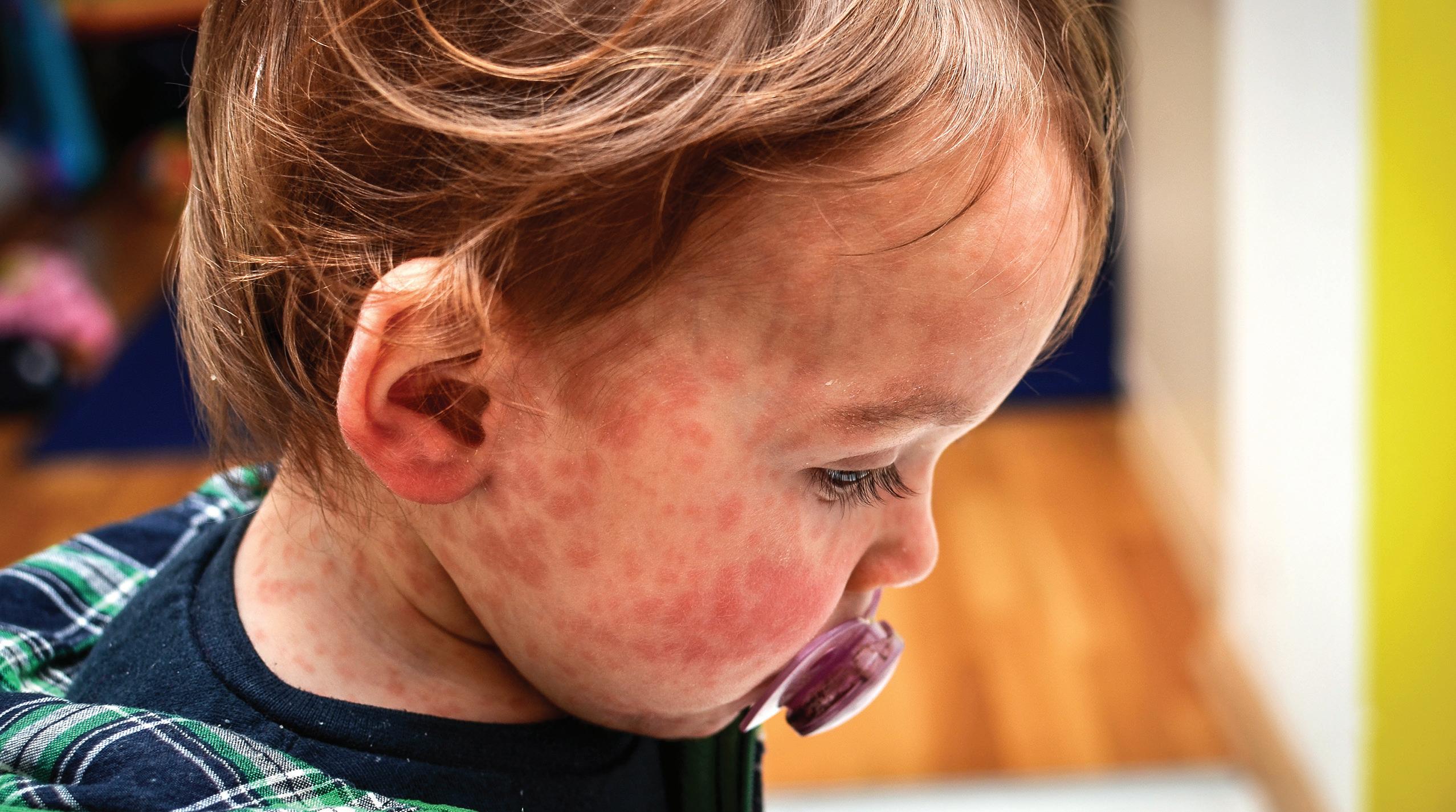
4 minute read
Measles–What Is Old Is New Again
Many of the readers of NBUSA Quarterly have children and grandchildren. Some have great grandchildren. Please encourage them to get their childhood vaccines. MMR vaccine saves lives and prevents disability for life.
Vaccinating children with the Measles, Mumps, Rubella (MMR) vaccine is vital and effective in protecting their health and the health of the community. These three highly contagious diseases can lead to severe complications such as pneumonia, brain swelling, hearing loss, or even death in extreme cases. At its peak, there were 500,000 cases of measles in the USA annually resulting in 500 deaths. Getting two doses of MMR vaccine reduces the chances of getting these diseases by about 97%. This article focuses on measles.
What is measles? Measles is a highly contagious, vaccine-preventable viral illness. There are four phases: 1) incubation, 2) prodrome, 3) rash, and 4) recovery.
Incubation lasts about 10-12 days after exposure; there are no symptoms.
Prodrome can last 2-4 days and begin with symptoms of fever, cough, coryza (runny nose), and conjunctivitis (red, watery eyes). Small white spots, known as Koplik spots, may appear inside the mouth 2–3 days after symptoms start.
Rash that is red and blotchy starts on the face and spreads down to the trunk, arms, legs, and feet. It usually appears 14 days after exposure and lasts about 5–6 days. Fever may spike during this phase, sometimes exceeding 104°F (40°C).
Recovery, the rash fades in the same order it appeared, and symptoms gradually resolve.
However, complications like ear infections, diarrhea, pneumonia, or encephalitis can occur, especially in young children, adults over 20, pregnant women, and those immunocompromised by medicines or comorbid illness. Ear infection and diarrhea occur in less than 10% of cases. Pneumonia occurs in about 5% (1 in 20) children. Encephalitis (brain swelling) in 1 in 1,000 cases. Some of the brain sequelae can be fatal, lead to disability, or occur up to a month after the initial infection. Other rare complications include hepatitis, myocarditis, or keratoconjunctivitis, which can lead eventually to blindness.
Because vaccination has been so successful, people have either forgotten or have never seen the results of measles. Instead, they get concerned about temporary side effects of the vaccine, which may include mild fever in 5–15% of people 6–12 days after vaccination, transient mild rash in ~5% of people, temporary joint pain in up to 25% of adult women but less common in children, and rarely transient swelling of neck and cheek glands. Severe side effects, such as allergic reactions (1 in a million doses) or febrile seizures (1 in 3,000), are extremely rare.
One side effect that is missing is autism because MMR vaccine does not cause autism. Multiple large studies have shown this. The one study that suggested a link was later found to be a fraudulent fabrication. This 1998 study by Andrew Wakefield was published in The Lancet. It was discovered later that Wakefield manipulated data and failed to disclose financial conflicts of interest. The study was retracted (removed permanently from The Lancet) in 2010, and Wakefield lost his medical license.
Measles is very infectious. The “attack rate” refers to the proportion of people exposed to a disease who become infected. It varies for different infections. Measles has a very high attack rate, as high as 90% among unvaccinated individuals exposed to the virus.
Immunizations protect the vaccinated as well as those around them, also called herd immunity. Herd immunity protects those who are unable to receive vaccines, such as newborns or individuals with compromised immune systems. This collective immunity helps prevents outbreaks in schools and communities. Herd immunity is most effective when the MMR vaccinate rate is >90%.
Please do not
Forget about the death, disability, and sickness measles can cause in unvaccinated people or communities with low vaccination rates.
Send children to go to “measles parties” to be intentionally infected with measles from an infected child, which is multiple times more risky than the vaccine, which has not caused a death in a healthy recipient.
Discourage MMR vaccination.
Overall, MMR vaccine is safe. It protects the recipient, those around them, and their community. There are decades of use and rigorous testing affirming its effectiveness. Side effects are generally mild and temporary. The benefits far outweigh the risks.
Dr. Stephen A. Wilson, MD, MPH, FAAFP, is Chair of Family Medicine at Boston University Chobanian and Avedisian School of Medicine and Chief of Family Medicine for Boston Medical Center.








